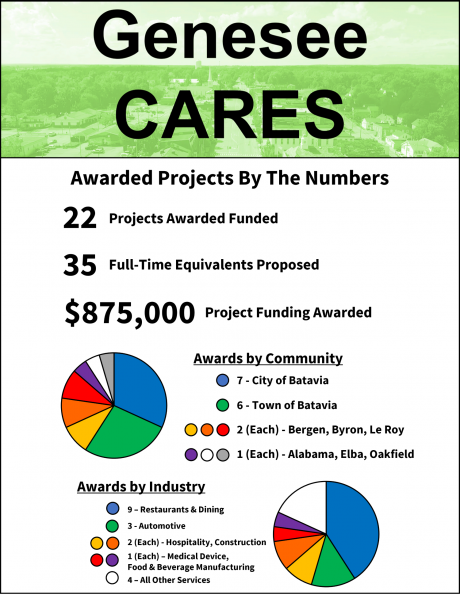The New York State Board on Electric Generation Siting and the Environment minutes ago, by a 5-1 vote, approved construction of the $345 million Excelsior Energy Center 280-megawatt utility scale solar project on 1,700 acres of farmland in the Town of Byron.
The vote capped a three-year effort by Excelsior Energy to develop the solar system under Article 10 of the state’s Public Service Law – and turned aside opposition to the proposal from Byron Association Against Solar, LLC, and the state Department of Agriculture and Markets.
Today’s action, broadcast live on the internet from Albany, came just two days before April 8, 2022 statutory deadline.
Members of the Siting Board panel voted following a 15-minute presentation by the Hon. Gregg C. Sayre, presiding examiner for the Department of Public Service, who found that the arguments forwarded by BAAS were not strong enough to delay, alter or relocate the project.
Votes in favor of the project were cast by Tammy Mitchell, director DPS Office of Electric, Gas and Water; Louis Alexander, representing the Department of Environmental Conservation; Elizabeth Lewis-Michl, director of the Department of Health Division of Environmental Health Assessment; Vincent Ravaschiere, senior vice president at Empire State Development, and John Williams, vice president for Policy and Regulatory Affairs of the New York State Energy Research and Development Authority.
Norman Pawlak, ad hoc member assigned to the project, cast the lone vote against the proposal.
Sayre stated that while the total project area is 3,443 acres, the “limit of disturbance for construction and operation” is 1,712 acres – with 1,629 inside the proposed project fences. He also mentioned that collection lines will be placed underground and a proposed substation and switching yard will connect the grid to a New York Power Authority 345-kilovolt transmission line nearby.
The project also includes a battery storage facility with a 20-megawatt, four-hour duration capacity, he said.
Three of the five parties in the matter – the DPS, Excelsior Energy and the Town of Byron – reached an agreement on details of the project in the fall of 2021, while the Department of Agriculture & Markets and BAAS joined together against it, including the hiring of a law firm to articulate its points to the Siting Board.
Sayre said the opposition’s key points focused on taking away much of Byron’s prime farmland, changing the “character of the community” and noncompliance with the comprehensive plans of Genesee County and the Town of Byron.
The administrative law judged addressed each one, as follows:
Using and Converting Prime Farmland
“The Department of Agriculture and Markets objected to 30 percent of the project being located on prime farmland and objected that a solar energy project constitutes a permanent conversion of farmland to non-agricultural uses. The draft order finds that the argument about permanent conversion of farmland has been considered before by the Siting Board and was rejected in the Hecate Energy Albany case decided in January of 2021,
“In that case, the Siting Board concluded that a commercial solar facility does not result in a permanent loss of farmland. Where, as in both that case, and in this case, the certificate conditions require the land to be fully restored as closely as possible to its prior condition upon decommissioning to the appropriate security for the decommissioning.
“In this case, there is some permanent loss of farmland due to access roads, and other similar construction, but it amounts to only about 31 acres, which is less than 1 percent of the project's area. The draft order also notes that the applicant has agreed to follow the Department of Agriculture & Markets guidelines for solar energy projects, which deal with construction mitigation for agricultural lands.
“The developer also has agreed to hire a health, safety and environmental manager with agricultural qualifications, as well as agreeing to various reporting requirements and coordinating requirements that involve in the future and … Department of Agriculture staff. Although the department is certainly correct, that agriculture agricultural production will be reduced in the footprint of the project for approximately 30 years, the reason behind that loss is that the property owners in question have voluntarily entered into lease agreements with the applicant.”
“BAAS offered two studies to support its position that the project will have a massive negative impact on farming in the Town of Byron. One of the reports was based on a completely erroneous number of affected acres, starting from the proposition that 3,500 acres of agricultural land would be removed from use for the life of the project. The correct acreage is 1,712 -- about half the amount in the study. That report is also deficient in using one year of crop pricing, in its analysis of impacts rather than a longer average given the price fluctuation that actually occurred over the course of several years in the town's top 10 crops.”
Destroying the ‘Small Town Feeling’
“BAAS offered the testimony of witnesses who stated that the visual impact of the project will destroy the small town feeling and tight knit community spirit of the area of the project. However, that testimony does not directly take issue with the significant visual screening measures that the applicant has agreed to take -- a fair number of plantings, the use of existing woodlands and hedgerows and other screening measures.
“The testimony also does not take direct issue with the visual impact analysis offered by the applicant that indicates that there is minimal expected visibility within the affected visual study area, which is the area within a radius of 5 miles around the fence line of a project. Under these circumstances, the draft order concludes that the BAAS testimony is overstated in claiming that the project will destroy the rural community, and finds that visual impacts have been avoided or minimized to the maximum extent practicable.”
Inconsistent with Comprehensive Plans
“The third issue in dispute is based on the testimony of a local resident who was speaking for himself, not for the town or the county, that the project is inconsistent with the town and county comprehensive plans. The resident is absolutely correct in stating that the protection of agricultural lands is listed as a goal and both of those plans.
“But the draft order finds that the argument of the project's inconsistency with these plans fails for three reasons. First, the town comprehensive plan also explicitly supports the development of clean energy resources. So, there is necessarily, as with most land use issues, some balancing required of competing goals.
“Second, the town in 2021 adopted a solar law that allows for some agricultural siting. The town found that the law was consistent with its comprehensive plan. And the county planning board implicitly found that the law was consistent with both the town and county comprehensive plans when it approved the town law. It is also noteworthy that the project disturbs less than 1 percent of the county's prime farmland.
“Third, as I noted, the … witness was speaking for himself. Neither the town or the county chose to file testimony or briefs against the project. The draft order concludes that the project is in fact not inconsistent with the town or county comprehensive plan.
“I should note that the applicant requested a waiver of 10 specific requirements of that town environmental law. The applicant produced evidence that with respect to these requirements, compliance would make it uneconomical to build the project. No party opposed those proposed waivers, and the order grants them.”
CLICK HERE for press release from the Siting Board.







